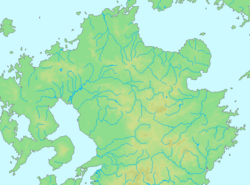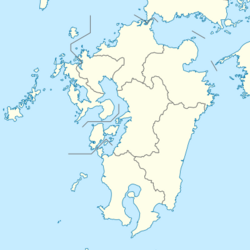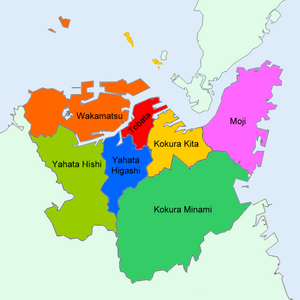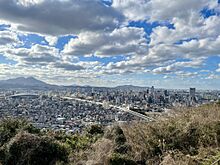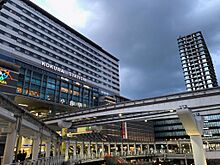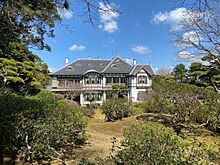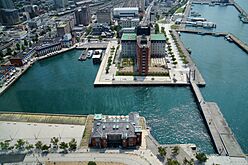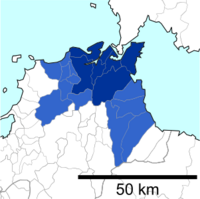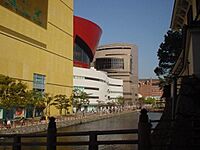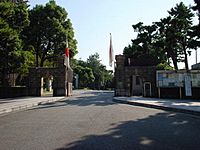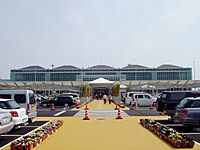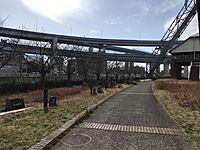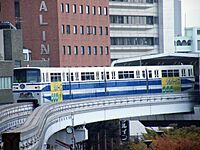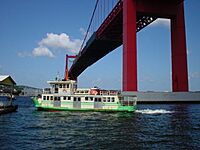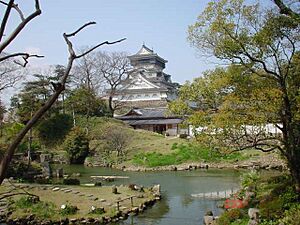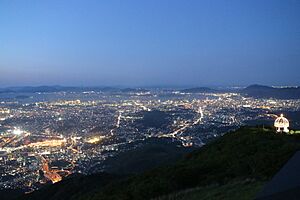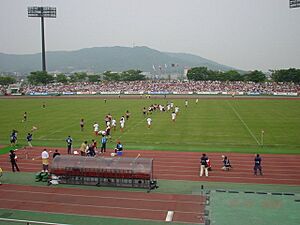Kitakyushu facts for kids
Quick facts for kids
Kitakyushu
北九州市
|
|||||||||||
|---|---|---|---|---|---|---|---|---|---|---|---|
| City of Kitakyushu | |||||||||||
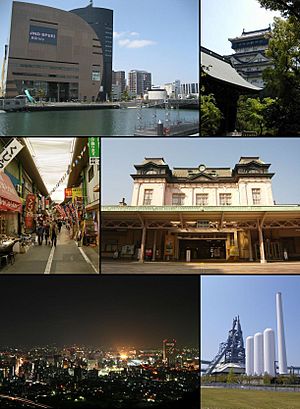
Clockwise from top left: the Riverwalk shopping center; Kokura Castle; Mojiko Station; the former Higashida blast furnace; a night view of Kokura from Mount Adachi; and the Tanga Market in Kokura
|
|||||||||||
|
|||||||||||
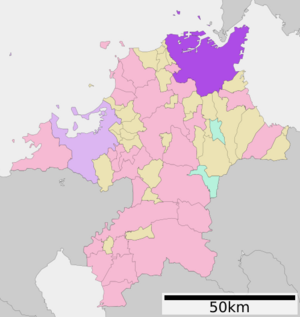 |
|||||||||||
| Country | Japan | ||||||||||
| Region | Kyushu | ||||||||||
| Prefecture | Fukuoka Prefecture | ||||||||||
| Area | |||||||||||
| • Total | 491.95 km2 (189.94 sq mi) | ||||||||||
| Population
(June 1, 2019)
|
|||||||||||
| • Total | 940,978 | ||||||||||
| • Density | 1,912.751/km2 (4,954.00/sq mi) | ||||||||||
| Time zone | UTC+09:00 (JST) | ||||||||||
| City hall address | 1-1 Jōnai, Kokura Kita-ku, Kitakyushu-shi, Fukuoka-ken 803-8501 |
||||||||||
| Climate | Cfa | ||||||||||
|
|||||||||||
Kitakyushu (Japanese: 北九州市, Hepburn: Kitakyūshū-shi) is a big city in Fukuoka Prefecture, Japan. It's like a special city chosen by the government. As of June 2019, about 940,978 people live there. This makes it the second-largest city in Fukuoka Prefecture and on the island of Kyushu, right after Fukuoka city.
Kitakyushu was created in 1963 when several towns, including the old city of Kokura, joined together. Its name means "North Kyushu City" in Japanese. It's located at the very northern tip of Kyushu, right on the Kanmon Straits. This narrow waterway separates Kyushu from Honshu, Japan's main island. Across the straits is the city of Shimonoseki. Kitakyushu and Shimonoseki are connected by bridges and tunnels, making it easy to travel between them.
Contents
- History of Kitakyushu
- Geography and How Kitakyushu is Divided
- Economy and Businesses in Kitakyushu
- Education in Kitakyushu
- Transportation in Kitakyushu
- Fun Places to Visit in Kitakyushu
- Culture and Fun in Kitakyushu
- Sports in Kitakyushu
- Sister Cities Around the World
- Famous People from Kitakyushu
- Images for kids
- History
- Geography and administrative divisions
- Economy
- Education
- Transportation
- Notable places
- Culture
- Sister cities
- Notable figures
- See also
History of Kitakyushu
How Kitakyushu Grew Over Time
Early Days of Kokura Prefecture
In 1871, a place called Kokura Prefecture was created. This happened when Japan changed its old clan system. The original wooden building that was the Kokura Prefectural Office is still there and is being fixed up. In 1876, Kokura Prefecture became part of Fukuoka Prefecture. The city of Kokura itself was officially founded in 1900.
Kitakyushu During World War II
During World War II, Yahata, a part of Kitakyushu, was a target for bombing raids by the United States. On August 9, 1945, the city of Kokura was the first target for a nuclear bomb. However, clouds and smoke from nearby Yahata made it impossible for the pilot to see clearly. Because of this, the bomb was dropped on Nagasaki instead.
The Birth of Kitakyushu City
The city of Kitakyushu was officially formed on February 10, 1963. It became a "designated city" on April 1, 1963. This new city was created by combining five towns: Moji, Kokura, Tobata, Yahata, and Wakamatsu. The city's symbol looks like a flower with five petals. Each petal represents one of the towns that merged to create Kitakyushu. The Japanese character for "north" (北, kita) is in the middle of the flower.
Geography and How Kitakyushu is Divided
Population and Size of Kitakyushu
As of October 2018, Kitakyushu had about 945,595 people living there. The city covers a total area of about 491.95 square kilometers. This means there are about 1,922 people living in each square kilometer. Kitakyushu is the 15th most populated city in Japan. It's also much larger than Fukuoka city in terms of land area.
Understanding Kitakyushu's Wards
Kitakyushu is divided into seven smaller areas called wards (ku in Japanese). Each ward has its own local office and helps manage the city.
| Wards of Kitakyushu | |||||
|---|---|---|---|---|---|
| Place Name | Map of Kitakyushu | ||||
| Rōmaji | Kanji | Color | Land area in km2 | ||
| 1 | Kokurakita-ku (administrative center) |
小倉北区 | 39.27 | ||
| 2 | Kokuraminami-ku | 小倉南区 | 170.25 | ||
| 3 | Moji-ku | 門司区 | 73.37 | ||
| 4 | Tobata-ku | 戸畑区 | 16.66 | ||
| 5 | Yahatahigashi-ku | 八幡東区 | 36.36 | ||
| 6 | Yahatanishi-ku | 八幡西区 | 83.04 | ||
| 7 | Wakamatsu-ku | 若松区 | 67.86 | ||
There was a plan for the city of Nakama, Fukuoka to become the eighth ward of Kitakyushu in 2005. However, Nakama's city council decided not to join Kitakyushu.
Views of Kitakyushu City
-
Downtown of Kokura (2014)
Kitakyushu's Climate and Weather
| Climate data for Yahatañishi-ku, Kitakyushu (1991−2020 normals, extremes 1977−present) | |||||||||||||
|---|---|---|---|---|---|---|---|---|---|---|---|---|---|
| Month | Jan | Feb | Mar | Apr | May | Jun | Jul | Aug | Sep | Oct | Nov | Dec | Year |
| Record high °C (°F) | 19.0 (66.2) |
24.0 (75.2) |
25.2 (77.4) |
30.1 (86.2) |
32.4 (90.3) |
34.2 (93.6) |
36.9 (98.4) |
36.7 (98.1) |
36.0 (96.8) |
33.0 (91.4) |
26.8 (80.2) |
24.8 (76.6) |
36.9 (98.4) |
| Mean daily maximum °C (°F) | 9.8 (49.6) |
10.9 (51.6) |
14.4 (57.9) |
19.6 (67.3) |
24.2 (75.6) |
27.0 (80.6) |
30.7 (87.3) |
31.9 (89.4) |
28.1 (82.6) |
23.2 (73.8) |
17.7 (63.9) |
12.2 (54.0) |
20.8 (69.5) |
| Daily mean °C (°F) | 6.2 (43.2) |
6.9 (44.4) |
10.0 (50.0) |
14.7 (58.5) |
19.3 (66.7) |
22.7 (72.9) |
26.8 (80.2) |
27.8 (82.0) |
24.0 (75.2) |
18.8 (65.8) |
13.3 (55.9) |
8.3 (46.9) |
16.6 (61.8) |
| Mean daily minimum °C (°F) | 2.8 (37.0) |
3.2 (37.8) |
5.9 (42.6) |
10.2 (50.4) |
14.9 (58.8) |
19.3 (66.7) |
23.7 (74.7) |
24.6 (76.3) |
20.6 (69.1) |
14.8 (58.6) |
9.3 (48.7) |
4.7 (40.5) |
12.8 (55.1) |
| Record low °C (°F) | −4.6 (23.7) |
−6.2 (20.8) |
−3.8 (25.2) |
0.5 (32.9) |
6.4 (43.5) |
10.5 (50.9) |
15.4 (59.7) |
17.6 (63.7) |
8.9 (48.0) |
3.5 (38.3) |
0.7 (33.3) |
−3.6 (25.5) |
−6.2 (20.8) |
| Average precipitation mm (inches) | 87.9 (3.46) |
79.2 (3.12) |
114.2 (4.50) |
125.4 (4.94) |
142.9 (5.63) |
239.5 (9.43) |
314.6 (12.39) |
198.1 (7.80) |
165.9 (6.53) |
85.2 (3.35) |
91.8 (3.61) |
75.9 (2.99) |
1,720.5 (67.74) |
| Average precipitation days (≥ 1.0 mm) | 10.8 | 10.4 | 10.9 | 10.0 | 9.0 | 12.3 | 11.8 | 10.0 | 9.7 | 7.3 | 9.4 | 9.8 | 121.4 |
| Mean monthly sunshine hours | 101.8 | 113.2 | 159.5 | 188.6 | 205.0 | 139.2 | 167.6 | 196.2 | 159.8 | 170.5 | 131.5 | 102.9 | 1,835.7 |
| Source: Japan Meteorological Agency | |||||||||||||
Economy and Businesses in Kitakyushu
Many important companies have their homes or major operations in Kitakyushu. Nippon Steel Corporation is a big employer, though its plants are smaller now than they used to be. The Zenrin company, famous for its maps and navigation software, is based here. Also, Toto Ltd., known for its plumbing products, and Yaskawa Electric Corporation, which makes robots and industrial equipment, are located in Kitakyushu.
StarFlyer, an airline, has its main office at Kitakyushu Airport. There's also a shopping center called Cha Cha Town in Kokura Kita ward. In 2009, Bridgestone Corporation opened a factory in Kitakyushu to make huge tires for construction and mining vehicles. The total economic output of the greater Kitakyushu area was about US$55.7 billion in 2010.
Education in Kitakyushu
Kitakyushu is home to many universities and colleges, offering various study programs.
Universities and Colleges in Kitakyushu
National Universities
- Kyushu Institute of Technology
Public Universities
- Kyushu Dental University
- University of Kitakyushu
Private Universities
- Kyushu International University
- Kyushu Kyoritsu University
- Kyushu Nutrition Welfare University
- Kyushu Polytechnic College
- Kyushu Women's University
- Nishinippon Institute of Technology
- Seinan Women's University
- University of Occupational and Environmental Health
Junior Colleges
- Higashi Chikushi Junior College
- Kyushu Women's Junior College
- Orio Aishin Junior College
- Seinan Jo Gakuin University Junior College
Technology Colleges
- Kitakyushu National College of Technology
Vocational Colleges
- Kyushu Medical Sports School
Research and Graduate Schools
- Kitakyushu Science and Research Park is a place where students can do advanced studies and research. It includes:
- Graduate School of International Environmental Engineering, The University of Kitakyushu
- Fukuoka University Institute for Recycling and Environmental Control Systems
- Graduate School of Life Science and Systems Engineering, Kyushu Institute of Technology
- Graduate School of Information, Production and Systems/Information, Production and Systems Research Center, Waseda University
Transportation in Kitakyushu
Kitakyushu is a very important place for travel between Honshu and Kyushu because of its location on the Kanmon Straits. It also has a large port.
Air Travel in Kitakyushu
Kitakyushu Airport
The Kitakyushu Airport opened on March 16, 2006. It's built on an artificial island in the Seto Inland Sea, which means planes can fly in and out 24 hours a day. A new airline called StarFlyer started flying from this airport when it opened.
Train Travel in Kitakyushu
Kokura Station is the main train station in Kitakyushu. All high-speed Shinkansen trains stop here before reaching Fukuoka. Local and express trains also serve the city. Inside the city, you can travel by the Kitakyushu Monorail and buses.
Mojikō Station is the end point for the Kagoshima Main Line, which is a very important train line for JR Kyushu.
Roads and Bridges in Kitakyushu
Expressways
The Kitakyushu area has its own network of expressways called the Kitakyushu Expressway. These roads help people travel quickly around the city. Kitakyushu is also on the Kyushu Expressway, which is the main north-south road on the island of Kyushu. To the north, the Kyushu Expressway crosses the Kanmonkyo Bridge and connects to the Chūgoku Expressway on Honshu.
Bridges
There are several important bridges in and around Kitakyushu. The biggest is the Kanmonkyo Bridge, which connects Kitakyushu to Shimonoseki across the Kanmon Straits. Another big bridge is the Wakato Bridge, which links the Tobata and Wakamatsu wards within the city.
Sea Travel in Kitakyushu
Kitakyushu Port
Kitakyushu has the largest ferry port in Kyushu. Ferries travel from Kitakyushu to many other cities in Japan, like Shimonoseki, Matsuyama, Kobe, Osaka, and Tokyo. You can also take ferries to Ulsan and Busan in Korea. There are also smaller ferries for daily travel within the Kanmon-Kitakyushu area.
Fun Places to Visit in Kitakyushu
- Kokura Castle (小倉城, Kokura-jō) was built in 1602. It was burned down in 1865 during a war, but it has been rebuilt and is a popular place to visit.
- Hiraodai (平尾台, lit. Flat Tail Plateau) is a unique limestone plateau where the rocks look like grazing sheep. It's a great place for walking and exploring caves.
- Mount Adachi (足立山, Adachi-san) and Mount Sarakura (皿倉山, Sarakura-san) offer amazing views of the city, especially at night.
- Kawachi Wisteria Garden is famous for its beautiful flower tunnels made of wisteria.
Culture and Fun in Kitakyushu
Kitakyushu has been featured in movies and video games. The 1986 family movie The Adventures of Milo and Otis was filmed here. The city also appears in the video game Call of Duty: Black Ops II as a map called Magma.
Festivals and Celebrations
Kitakyushu is known for its lively summer festivals called matsuri. Many of these festivals are very old, going back about 400 years. They were started to celebrate surviving epidemics.
- Kurosaki Gion (July): People pull highly decorated "battle floats" through the streets.
- Tobata Gion (July): People carry huge floats called yamagasa on their shoulders. These floats are decorated with flags during the day and lanterns at night.
- Kokura Gion (July): People pull yamagasa parade floats along the street.
- Moji Minato Festival (May): This port festival features people in colorful costumes pulling floats.
- Wakamatsu Minato Festival (July): This festival celebrates fire, drums, and mythical creatures called kappa.
- Wasshoi Hyakuman Festival (August): This big festival brings together all the local festivals for a grand parade near City Hall. It celebrates the merging of the five towns that formed Kitakyushu.
- Green Park Flea Market (monthly, except August and December): You can find over 200 shops here.
Center for Contemporary Art (CCA) Kitakyushu
The Center for Contemporary Art opened in 1997. It shows works by famous international artists and helps new artists develop their skills.
Sports in Kitakyushu
Kitakyushu is a city that loves sports! It was chosen to host the 2021 World Artistic Gymnastics Championships and the 2021 Rhythmic Gymnastics World Championships.
Professional Sports Teams
- Giravanz Kitakyushu is the city's professional football team, playing in the J3 League.
Sporting Venues and Stadiums
Kitakyushu has many places for sports events, including:
- Anō Dome
- Mikuni World Stadium Kitakyushu - Home stadium for Giravanz Kitakyushu
- Honjō Athletic Stadium
- Kitakyushu City General Gymnasium
- Kitakyushu Media Dome - An indoor stadium for bicycle racing (Keirin)
- Kitakyushu Municipal Baseball Stadium
- Kitakyushu Municipal Gymnasium
- JRA Kokura Racecourse
- Sayagatani Stadium
- Wakamatsu Kyōteijō - For boat races
Sister Cities Around the World
Kitakyushu has special partnerships with cities in other countries. These are called "sister cities."
 Surabaya, Indonesia (since 1992)
Surabaya, Indonesia (since 1992) Dalian, Liaoning, China
Dalian, Liaoning, China Incheon, South Korea
Incheon, South Korea Norfolk, Virginia, United States
Norfolk, Virginia, United States Tacoma, Washington, United States
Tacoma, Washington, United States Haiphong, Vietnam
Haiphong, Vietnam Davao City, Philippines
Davao City, Philippines Phnom Penh, Cambodia
Phnom Penh, Cambodia Ipatinga, Minas Gerais, Brazil (since July 24, 1978)
Ipatinga, Minas Gerais, Brazil (since July 24, 1978)
Kitakyushu also has one sister city in Japan:
Famous People from Kitakyushu
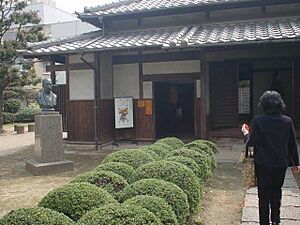
Samurai Warriors
- Miyamoto Musashi: A legendary samurai swordsman and author of The Book of Five Rings. He lived in Kokura castle for many years.
Writers and Authors
- The novelist Mori Ōgai lived in Kokura. His house is now open to the public.
- The writer Seichō Matsumoto was born in Kokura. There's a museum dedicated to his work near Kokura Castle.
- The writer Ashihei Hino was born in Wakamatsu ward, and you can visit his birthplace.
Scientists and Researchers
- Professor Ted Fujita: Known as "Mr. Tornado" in America for his work on tornadoes, he was born in what is now Kokura Minami ward.
Sports Stars
- Masanobu Fuchi: A Japanese professional wrestler.
- Hina Hayata: A Japanese table tennis athlete.
- Shōta Imanaga: A Japanese professional baseball pitcher who plays for the Chicago Cubs in Major League Baseball.
- Hina Sugita: A Japanese football (soccer) athlete.
Musicians and Singers
- 175R: A Japanese punk rock band.
- Ayaka Umeda: A former Japanese idol and singer.
- Rihito Ikezaki: A member of the Japanese boy group INI.
Film Directors
- Yamazaki Tokujirō: Director of Call of the Foghorn.
- Aoyama Shinji: Director of Eureka.
- Oda Motoyoshi: Director of Godzilla Raids Again.
- Hirayama Hideyuki: Director of Forget me Not.
Actors and Actresses
- Takeshi Tsuruno: Known for Ultraman Dyna.
- Kazuhisa Kawahara: Appeared in Aibō.
- Takahiro Fujimoto: Acted in Saka no Ue no Kumo.
- Saaya Irie: Starred in God's Left Hand, Devil's Right Hand.
- Tsuyoshi Ihara: Known for roles in Letters from Iwo Jima.
- Junichi Haruta: Appeared in many "Super Sentai" series like Dai Sentai Goggle-V.
Images for kids
|
Kitakyushu
北九州市
|
|||||||||||
|---|---|---|---|---|---|---|---|---|---|---|---|
| City of Kitakyushu | |||||||||||

Clockwise from top left: the Riverwalk shopping center; Kokura Castle; Mojiko Station; the former Higashida blast furnace; a night view of Kokura from Mount Adachi; and the Tanga Market in Kokura
|
|||||||||||
|
|||||||||||
 |
|||||||||||
| Country | Japan | ||||||||||
| Region | Kyushu | ||||||||||
| Prefecture | Fukuoka Prefecture | ||||||||||
| Area | |||||||||||
| • Total | 491.95 km2 (189.94 sq mi) | ||||||||||
| Population
(June 1, 2019)
|
|||||||||||
| • Total | 940,978 | ||||||||||
| • Density | 1,912.751/km2 (4,954.00/sq mi) | ||||||||||
| Time zone | UTC+09:00 (JST) | ||||||||||
| City hall address | 1-1 Jōnai, Kokura Kita-ku, Kitakyushu-shi, Fukuoka-ken 803-8501 |
||||||||||
| Climate | Cfa | ||||||||||
|
|||||||||||
Kitakyushu (Japanese: 北九州市, Hepburn: Kitakyūshū-shi) is a city located in Fukuoka Prefecture, Japan. As of June 1, 2019, Kitakyushu has an estimated population of 940,978, making it the second-largest city in both Fukuoka Prefecture and the island of Kyushu after the city of Fukuoka. It is one of Japan's 20 designated cities, one of three on Kyushu, and is divided into seven wards.
Kitakyushu was formed in 1963 from a merger of municipalities centered on the historic city of Kokura, and its name literally means "North Kyushu City" in Japanese. It is located at the northernmost point of Kyushu on the Kanmon Straits, separating the island from Honshu, across from the city of Shimonoseki. Kitakyushu and Shimonoseki are connected by numerous transport links including the Kanmon Bridge and the Kanmon Tunnels (Roadway, Railway, and Shin-Kanmon). Kitakyushu's Urban Employment Area forms part of the Fukuoka-Kitakyushu Greater Metropolitan Region, which, with a population of 5,738,977 (2005-2006), is the largest metropolitan area in Japan west of the Keihanshin region.
History
Kokura Prefecture
Kokura Prefecture was founded separately from Fukuoka Prefecture in 1871 when the clan system was abolished. The old wooden-built Kokura Prefectural Office is still standing and is being restored. It is opposite Riverwalk Kitakyūshū. In 1876, Kokura Prefecture was absorbed by Fukuoka Prefecture. The city of Kokura was founded in 1900.
World War II
Yahata in Kitakyushu was the target for the beginning of the US bombing raids on the home islands on June 16, 1944, when 75 Boeing B-29 Superfortresses flew out from mainland China.
Kokura was the primary target of the nuclear weapon "Fat Man" on August 9, 1945. Major Charles Sweeney had orders to drop the bomb visually. All three attempts failed due to clouds and smoke from Yahata, which is only 7 km (4.3 mi) west of Kokura and had air raids on the previous day, preventing him from identifying the target clearly. Additionally, a smoke screen was created by industrial workers burning barrels of coal tar and/or electric plant workers releasing steam. The bomb was ultimately dropped on the city of Nagasaki, the secondary target, at 11:02 JST.
City
The city of Kitakyushu was founded on February 10, 1963, and was designated on April 1, 1963, by government ordinance. The city was born from the merger of five municipalities (Moji, Kokura, Tobata, Yahata and Wakamatsu) centered around the ancient feudal city of Kokura. The city's symbol mark is a flower with the character "north" (北, kita) in the middle and five petals representing the towns that merged.
Geography and administrative divisions
Demographics
As of 1 October 2018[update], the city had an estimated population of 945,595 and a total area of 491.95 km2 (189.94 sq mi). The average population density is 1,922 persons /km2 (4,980/sq mi). It is now the country's 15th most populated city. It has a much larger total area than that of Fukuoka which is only 343.39 km2 (132.58 sq mi).
Wards
Kitakyushu has seven wards (ku):
| Wards of Kitakyushu | |||||
|---|---|---|---|---|---|
| Place Name | Map of Kitakyushu | ||||
| Rōmaji | Kanji | Color | Land area in km2 | ||
| 1 | Kokurakita-ku (administrative center) |
小倉北区 | 39.27 | ||
| 2 | Kokuraminami-ku | 小倉南区 | 170.25 | ||
| 3 | Moji-ku | 門司区 | 73.37 | ||
| 4 | Tobata-ku | 戸畑区 | 16.66 | ||
| 5 | Yahatahigashi-ku | 八幡東区 | 36.36 | ||
| 6 | Yahatanishi-ku | 八幡西区 | 83.04 | ||
| 7 | Wakamatsu-ku | 若松区 | 67.86 | ||
The city of Nakama, Fukuoka was to become the eighth ward of Kitakyushu in 2005 (to be called Nakama-ku). However, the merger was rejected on December 24, 2004 by Nakama's city council, despite having been initiated by Nakama City.
Cityscape
-
Downtown of Kokura (2014)
Climate
| Climate data for Yahatañishi-ku, Kitakyushu (1991−2020 normals, extremes 1977−present) | |||||||||||||
|---|---|---|---|---|---|---|---|---|---|---|---|---|---|
| Month | Jan | Feb | Mar | Apr | May | Jun | Jul | Aug | Sep | Oct | Nov | Dec | Year |
| Record high °C (°F) | 19.0 (66.2) |
24.0 (75.2) |
25.2 (77.4) |
30.1 (86.2) |
32.4 (90.3) |
34.2 (93.6) |
36.9 (98.4) |
36.7 (98.1) |
36.0 (96.8) |
33.0 (91.4) |
26.8 (80.2) |
24.8 (76.6) |
36.9 (98.4) |
| Mean daily maximum °C (°F) | 9.8 (49.6) |
10.9 (51.6) |
14.4 (57.9) |
19.6 (67.3) |
24.2 (75.6) |
27.0 (80.6) |
30.7 (87.3) |
31.9 (89.4) |
28.1 (82.6) |
23.2 (73.8) |
17.7 (63.9) |
12.2 (54.0) |
20.8 (69.5) |
| Daily mean °C (°F) | 6.2 (43.2) |
6.9 (44.4) |
10.0 (50.0) |
14.7 (58.5) |
19.3 (66.7) |
22.7 (72.9) |
26.8 (80.2) |
27.8 (82.0) |
24.0 (75.2) |
18.8 (65.8) |
13.3 (55.9) |
8.3 (46.9) |
16.6 (61.8) |
| Mean daily minimum °C (°F) | 2.8 (37.0) |
3.2 (37.8) |
5.9 (42.6) |
10.2 (50.4) |
14.9 (58.8) |
19.3 (66.7) |
23.7 (74.7) |
24.6 (76.3) |
20.6 (69.1) |
14.8 (58.6) |
9.3 (48.7) |
4.7 (40.5) |
12.8 (55.1) |
| Record low °C (°F) | −4.6 (23.7) |
−6.2 (20.8) |
−3.8 (25.2) |
0.5 (32.9) |
6.4 (43.5) |
10.5 (50.9) |
15.4 (59.7) |
17.6 (63.7) |
8.9 (48.0) |
3.5 (38.3) |
0.7 (33.3) |
−3.6 (25.5) |
−6.2 (20.8) |
| Average precipitation mm (inches) | 87.9 (3.46) |
79.2 (3.12) |
114.2 (4.50) |
125.4 (4.94) |
142.9 (5.63) |
239.5 (9.43) |
314.6 (12.39) |
198.1 (7.80) |
165.9 (6.53) |
85.2 (3.35) |
91.8 (3.61) |
75.9 (2.99) |
1,720.5 (67.74) |
| Average precipitation days (≥ 1.0 mm) | 10.8 | 10.4 | 10.9 | 10.0 | 9.0 | 12.3 | 11.8 | 10.0 | 9.7 | 7.3 | 9.4 | 9.8 | 121.4 |
| Mean monthly sunshine hours | 101.8 | 113.2 | 159.5 | 188.6 | 205.0 | 139.2 | 167.6 | 196.2 | 159.8 | 170.5 | 131.5 | 102.9 | 1,835.7 |
| Source: Japan Meteorological Agency | |||||||||||||
Economy
Nippon Steel Corporation is a major employer, but the Yahata and Tobata plants are much reduced from their heyday of the 1960s. The Zenrin company known for its mapping and navigation software is based here and so is Toto Ltd. and Yaskawa Electric Corporation. StarFlyer, an airline, is headquartered on the grounds of Kitakyushu Airport in Kokuraminami-ku, Kitakyūshū. Previously the airline's headquarters were in the Shin Kokura Building (新小倉ビル, Shin-Kokura Biru) in Kokurakita-ku, Kitakyūshū.
A smaller scale shopping center known as Cha Cha Town, next to the Sunatsu bus depot in Kokura Kita ward, was created by the Nishi-Nippon Railroad and bus company.
In 2009 Bridgestone Corporation opened a plant in Kitakyushu to produce large and ultralarge off-the-road radial tires for construction and mining vehicles.
The GDP in Greater Kitakyushu, Kitakyushu Metropolitan Employment Area was US$55.7 billion in 2010.
Education
Universities and colleges
National universities
- Kyushu Institute of Technology
Public universities
- Kyushu Dental University
- University of Kitakyushu
Private universities
- Kyushu International University
- Kyushu Kyoritsu University
- Kyushu Nutrition Welfare University
- Kyushu Polytechnic College
- Kyushu Women's University
- Nishinippon Institute of Technology
- Seinan Women's University
- University of Occupational and Environmental Health
Junior colleges
- Higashi Chikushi Junior College
- Kyushu Women's Junior College
- Orio Aishin Junior College
- Seinan Jo Gakuin University Junior College
Technology colleges
- Kitakyushu National College of Technology
Vocational colleges
- Kyushu Medical Sports School
Research Institutes and graduate schools
- Kitakyushu Science and Research Park
- Graduate School of International Environmental Engineering, The University of Kitakyushu
- Fukuoka University Institute for Recycling and Environmental Control Systems
- Graduate School of Life Science and Systems Engineering, Kyushu Institute of Technology
- Graduate School of Information, Production and Systems/Information, Production and Systems Research Center, Waseda University
Transportation
Located at a strategic position on the south side of the Kanmon Straits, Kitakyushu is an important transport hub for traffic between Honshu and Kyushu and has a large port.
Air
Airport
The Kitakyushu Airport opened on March 16, 2006. It is larger than the previous Kokura Airport and supports 24-hour operations thanks to its location on an artificial island in the Seto Inland Sea. It will eventually be connected with Kokura Station by a new fast rail link. A new airline based in the city called StarFlyer began operations when the airport opened.
Railways
Kokura Station, the city's central train station, is the penultimate stop on the JR West Sanyō Shinkansen before the Fukuoka terminus and all Shinkansen services stop here. It is served by local and express trains on JR Kyushu's Kagoshima and Nippō Main Lines. In the city, transport is provided the Kitakyushu Monorail and buses.
Mojikō Station in Moji-ku is the northern terminus of the Kagoshima Main Line, the most important line in the JR Kyushu network.
A tram network operated by the Nishi-Nippon Railroad known as the Kitakyushu Line once operated in the city; after dwindling passenger numbers in the 1970s the line was shut down in stages between 1980 and 2000. A railway using tram cars, the Chikuhō Electric Railroad, runs between Kurosaki-Ekimae and Chikuhō-Nōgata stations, serving Yahatanishi-ku and the neighboring city of Nōgata.
Roads
Expressways
The metropolitan area of Kitakyushu is covered by the Kitakyushu Expressway, which has five routes serving the city, totaling 53 kilometers of four-lane expressways. Some of these expressways are elevated, especially around the city center. Route 1 serves the city center, while route 2 serves the port area. Route 3 is a short connector between routes 1 and 2, and route 4 is the longest of the Kitakyushu Expressway network, serving most of the city from north to south. Route 5 is a short link serving the inner port area.
In addition, Kitakyushu is bypassed by the Kyushu Expressway, the main north–south route on the island of Kyushu. The new Higashikyushu Expressway begins in Kitakyushu and runs along the eastern coast of Kyushu. North of Kitakyushu, the Kyushu Expressway crosses the six-lane Kanmonkyo Bridge and turns into the Chūgoku Expressway, the second longest in Japan, serving western Honshu.
Bridges
There are several bridges in Kitakyushu and between the city and other places. The largest ones are the Kanmonkyo Bridge linking Kitakyushu and Shimonoseki (on Kyushu and Honshū respectively) via the Kanmon Straits and the Wakato Bridge linking the wards of Tobata and Wakamatsu. There are smaller bridges over the Onga River on the western border of the city.
On September 30, 2005, ownership of the Wakato Bridge was transferred from Japan Highway Public Corporation to Kitakyushu; on April 1, 2006, the bridge was transferred to the control of the Kitakyushu City Road Public Corporation.
Sea
Port
Kitakyushu is the largest ferry port in Kyushu, Chūgoku, and Shikoku. Ferry services operate between Kitakyushu and Shimonoseki, Matsuyama, Tokushima, Kōbe, Ōsaka, Tokyo, Ulsan (Korea), Busan (Korea) and isolated islands in the city limits. The main ferry port is at Shin-Moji, and there are ferries at Moji and near Kokura Station.
In the Kanmon-Kitakyushu area, there are three commuter lines: the Wakato Ferry, the Kanmon Straits Ferry, and the Kanmon Straits Liner.
Notable places
- Kokura Castle (小倉城, Kokura-jō) was built by Hosokawa Tadaoki in 1602. It was the property of the Ogasawara clan (from Harima) between 1632 and 1860. The castle was burnt down in 1865 in the war between the Kokura and Choshu clans.
- Hiraodai (平尾台, lit. Flat Tail Plateau) karst plateau and Mount Adachi (足立山, Adachi-san) in Kokura Minami ward and Mount Sarakura (皿倉山, Sarakura-san) and Kawachi Dam (河内貯水池, Kawachi-chosuichi) in Yahata Higashi ward are noted walking areas with fine scenery.
- Kawachi Wisteria Garden is known for massive flower trellises.
The limestone outcroppings on Hiraodai are said to resemble grazing sheep, so the plateau, the highest in Kyushu at 400–600 meters, is also known as the Yogun Plain. Some of the limestone caverns are open to the public. The area contains the Sugao and Nanae Waterfalls. Sugao is about 20 meters. Nanae means "seven stages".
Culture
The 1986 family movie Koneko Monogatari was filmed here. The English version of the film, which is the story of the friendship of a kitten and a pug dog, was released in America in 1989 as The Adventures of Milo and Otis.
The 1958 comedy Rickshaw Man is based on a local folk hero of Kokura called Muhomatsu or "Wild Pine" and has been called the Japanese "Desperado". He is celebrated in the Kokura Gion Yamagasa festival. Toshiro Mifune plays the taiko drum in this movie.
Kitakyushu is featured in the late 2012 Call of Duty: Black Ops II game developed by Treyarch and published by Activision as a DLC map called Magma. In the map the city has been abandoned due to a volcanic eruption, and parts of the city are completely covered in lava.
Festivals
There are festivals (matsuri) held in the summer in the city, including the Tobata Gion Yamagasa festival in Tobata-ku, Kitakyūshū.
- Kurosaki Gion (July)
It has been designated as an intangible cultural asset of Fukuoka Prefecture. People spin highly decorated "battle floats" as they pull them through the streets.
- Tobata Gion (July)
People carry yamagasa (tiered floats decorated with flags by day and lanterns by night) on their shoulders.
- Kokura Gion (July)
People pull yamagasa parade floats along the street.
All the Gion festivals date back about 400 years. They were instituted to celebrate surviving an epidemic.
- Moji Minato Festival (May)
This port-city festival involves colorfully costumed people pulling floats through the streets.
- Wakamatsu Minato Festival (July)
This port-city festival celebrates fire, drums, and kappa (mythical amphibious creatures who love cucumbers).
- Wasshoi Hyakuman Festival (August)
The Wasshoi Hyakuman Natsumatsuri brings all the festivals together for a grand parade and finale near City Hall in Kokura Kita ward. Kitakyushu was formed by the merging of Kokura, Yahata, Wakamatsu, Moji, and Tobata. As a result, the city began, on its tenth anniversary, to combine these local festivals into one. On the 25th anniversary, it was renamed Wasshoi Hyakuman because the city population had reached one million.
- Green Park Flea Market (monthly, except August and December)
There are over 200 shops.
Center for Contemporary Art (CCA) Kitakyushu
The Center for Contemporary Art opened in May 1997 by former Japan Foundation chief curator Nobuo Nakamura and Akiko Miyake. The centre has shown works of internationally renowned artists such as Maurizio Cattelan and Anri Sala, and runs an internationally acclaimed studio programme for emerging artists.
Sports
Kitakyushu was selected as the host of the 2021 World Artistic Gymnastics Championships and the 2021 Rhythmic Gymnastics World Championships, both of which will take place in October 2021. The artistic gymnastics championship will take place in Kitakyushu City General Gymnasium, while the rhythmic competition will be contested in the West Japan Exhibition Centre.
Professional teams
Sporting venues
- Anō Dome
- Mikuni World Stadium Kitakyushu - Home stadium for Giravanz Kitakyushu
- Honjō Athletic Stadium
- Kitakyushu City General Gymnasium
- Kitakyushu Media Dome - Indoor Keirin stadium
- Kitakyushu Municipal Baseball Stadium
- Kitakyushu Municipal Gymnasium
- JRA Kokura Racecourse
- Sayagatani Stadium
- Wakamatsu Kyōteijō - Wakamatsu Boat Races
Sister cities
Kitakyushu is twinned with the following cities outside Japan.
 Surabaya, Indonesia, since 1992
Surabaya, Indonesia, since 1992 Dalian, Liaoning, China
Dalian, Liaoning, China Incheon, South Korea
Incheon, South Korea Norfolk, Virginia, United States
Norfolk, Virginia, United States Tacoma, Washington, United States
Tacoma, Washington, United States Haiphong, Vietnam
Haiphong, Vietnam Davao City, Philippines
Davao City, Philippines Phnom Penh, Cambodia
Phnom Penh, Cambodia Ipatinga, Minas Gerais, Brazil, since July 24, 1978
Ipatinga, Minas Gerais, Brazil, since July 24, 1978
One city in Japan is twinned with Kitakyushu;
Notable figures

Samurai
- Miyamoto Musashi, samurai swordsman, author of The Book of Five Rings and founder of the Hyoho Niten Ichi-ryū, famous for its use of two swords. He lived in the Kokura castle under the patronage of the Ogasawara and Hosokawa clans from 1633 until his death.
Writers
- The novelist Mori Ōgai lived in Kokura for years and his house is open to the public in Kokura Kita ward. He wrote Kokura Nikki (Kokura Diary) here. It is a ten-minute walk from Kokura Station.
- The writer Seichō Matsumoto was born in Kokura. The Matsumoto Seicho Memorial Museum dedicated to his work is located in the city center near Kokura Castle.
- The writer Ashihei Hino was born in Wakamatsu ward and his birthplace can be visited.
Scientists
- Professor Ted Fujita, popularly known as "Mr. Tornado" in America, was born in Kikugaoka in what is now Kokura Minami ward.
Sportspeople
- Masanobu Fuchi, Japanese professional wrestler (All Japan Pro-Wrestling)
- Hina Hayata, Japanese table tennis athlete
- Shōta Imanaga (今永 昇太, Imanaga Shōta, born September 1, 1993), nicknamed "The Throwing Philosopher", is a Japanese professional baseball pitcher for the Chicago Cubs of Major League Baseball (MLB). He played in Nippon Professional Baseball (NPB) for the Yokohama DeNA BayStars from 2016 to 2023. Imanaga is a two-time NPB All-Star and he led the Central League in strikeouts in 2023 before signing with the Cubs during the 2023–24 offseason.
- Hina Sugita, Japanese football athlete
Musicians
- 175R, a Japanese punk rock band
- Ayaka Umeda, former Japanese idol and singer (AKB48, the subunit DiVA and NMB48)
- Rihito Ikezaki, member of INI (Japanese boy group)
Film directors
- Yamazaki Tokujirō, director of Call of the Foghorn and the Jiken Kisha series
- Aoyama Shinji, director of Eureka and Sad Vacation
- Oda Motoyoshi, director of Godzilla Raids Again
- Hirayama Hideyuki, director of Forget me Not
Actors
- Takeshi Tsuruno, Ultraman Dyna
- Kazuhisa Kawahara, Aibō, Initial D and Kamen Rider Decade
- Takahiro Fujimoto, Saka no Ue no Kumo, Jin and Segodon
- Saaya Irie, God's Left Hand, Devil's Right Hand
- Tsuyoshi Ihara, Ninja, Dirty Hearts, Letters from Iwo Jima and Samurai Hustle (real name: Yun Yu-gu, Hangul: 윤유gu)
- Junichi Haruta, Dai Sentai Goggle-V, Kagaku Sentai Dynaman, Kamen Rider Blade, Kamen Rider W Returns and Zyuden Sentai Kyoryuger
See also
 In Spanish: Kitakyushu para niños
In Spanish: Kitakyushu para niños




